英汉翻译电子教案1
- 格式:doc
- 大小:94.50 KB
- 文档页数:8
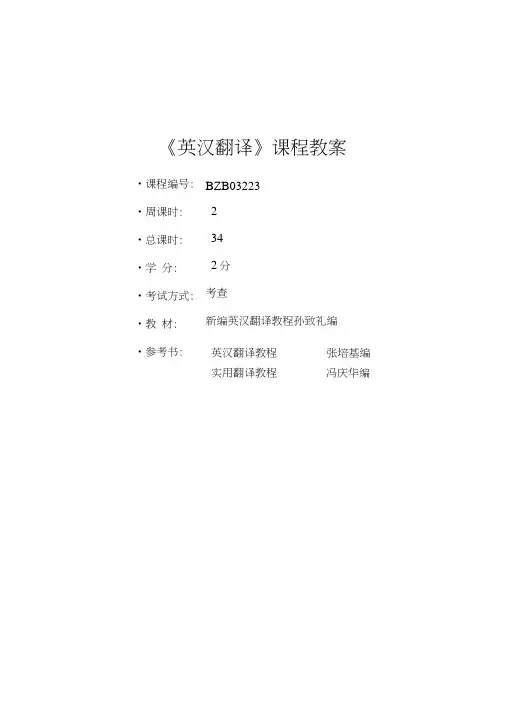
《英汉翻译》课程教案•课程编号: •周课时: •总课时: •学分: •考试方式: •教材: •参考书: BZB032232342分考查新编英汉翻译教程孙致礼编英汉翻译教程张培基编实用翻译教程冯庆华编ContentsChapter 1 What Is Translation (1)Chapter 2 The Process of Translation (15)Chapter 3 The linguistic Approach toTranslation (25)Chapter 4 Conversion (35)Chapter 5 The importance of diction (43)Chapter 6 Translation concerning negation (48)Chapter 7 Ampliflcation (53)Chapter 8 Repetition (58)Chapter 9 Changes of sentence parts (62)Chapter 10 Translation of attributive clause (66)Chapter 11 Translation of Long Sentences (69)Chapter 12外位语结构在英译汉中的应用 (73)Chapter 13 Translation of Passive Voice (77)Chapter 14 Translation of figures of speech (83)Chapter 15 Translation of idioms (87)Chapter 1 What Is TranslationAims: To understand the basic principles of translation and translation studiesKey points: the nature of translation, definition of translationDifficulties: the nature of translation, history of translationTeaching procedures1.The nature of translation•Translation is of great importance in learning a foreign language. Many of those who learn English will be English Chinese translators in the future. There are many translation theories and techniques for you too learn .•Without knowing the theories and the techniques one will most likely take a roundabout course in translation work. That's why it is necessary for you to have a good command of both the source language and the target language, and of the theories and the techniques in translation.•What is translation?Translation is a representation or recreation in one language of what is written or said in another language.or : Translation is an activity of reproducing in one language the ideas which have been expressed in another language.(翻译是把一种语言所表达的思想用另一种语言重新表达出來的活动)•Eugene Nida, famous American translation theorist, defined translation as: Translation consists in reproducing in the receptor language the closest natural equivalent of the source-language messages, first in terms of meaning and secondly in terms of style.•翻译就是接受语言复制出与原语信息最接近的自然等值体…首先是就意义而言,其次是就其风格而言.Eugene Nida^s photo •In addition to the definitions mentioned above, various definitionshave been given to translation. Now Fd like to cite some of them:•Translation is a science ••Translation is an art.•Translation is a craft.•Translation is a skill.•Translation is an operation .•Translation is a language activity .•Translation is a communication.•Among these definitions the first two are most important for they represent two schools ■一the school of science and the school of art. The former maintains that translating should reproduce the message of the original by means of the transformation of linguistic equivalence. It puts stress on the study of description of the process of translation, and the structures and the forms of the language so as to reveal the objective laws inherent in translation. The latter advocates recreating a literary work by using expressions of another language • It emphasizes on the effect of translation.1) Translation is a science•We say translation is a science, because it has its own laws and methods. Take the translation between English and Chinese for example, if we want to translate well, we must be entirely familiar with the content of the original and all the knowledge it concerns. In addition we should have a comparatively comprehensive and thorough study of English and Chinese so that we may do our work with high proficiency.•English and Chinese are two entirely different languages. Each has an individual and distinct system. On the other hand, there are lots of differences between them both in morphology and in syntax. Because of this , we have to know both languages well, especially with the wide difference in vocabulary , grammatical relations,and sentence structure .•Now we may well conclude that translation is indeed a science with its peculiar laws and methods,a science related to lexicology .grammar, rhetoric and other branches of linguistics.2) Translation is an arte Lin Yutang was once a representative. In his essay On Translation he declares that translation is an art whose success depends on one^s artistic talent and enough training.Besides these, there no set rules for translation and there is no short cut for art.•From the examples mentioned above we can see that translation is an art, a brilliant art. Like painting, enables us to reproduce the fine thought of somebody, not in colors, but in words, in the words of a different language< It demands a broad and profound knowledge. •In other words , a translator should have an understanding of literature and art, rhetoric and aesthetics; otherwise, he can hardly accomplish the task of reproduction of the original.•In accordance with what we have discussed in the above, now we can come to the following conclusion:•Translation depends on the artistic level and the technique of the translato匸Whoever has a good command of translation both in theory and technique can offer satisfactory translations Jt is because ,as pointed out in this lecture , translation is not only a science with its own laws and methods but also an art of reproduction and recreation.2.Aim of foreign language learning and the importance of translation(1) What is the objects of a foreign language? Learning a foreign language is not easy but it is worthwhile. It enables you to read foreign scientific and technical literature, and that might be useful. It makes you enable to read some of the worlds best writers in their own language, and this is a great pleasure. But the most important thing is that it gives you a better understanding of your own language.(2) Translation is of great value to foreign language learners. It is very important to the development of our nation • Translation keeps you informed of the international situation ; translation enhances our competitive power in the international market ; translation serves as instrument of propagating traditional culture . Translation is for inter-lingual communication, bridges the gulf between different-tongue speakers,and reproduces and spreads the message in the original language. Translation permits knowledge to be transmitted to different corners of the world and to succeeding generations.•Translation gives information, reveals feelings, and affect people's thought or behavio匚Through translation, we can draw on the advanced experience and achievement in the fieldof science and technology of foreign countries. Without translation, the worldwide civilization would not be possible.•Today, translation plays an increasingly important role in our country's economic reform and opening to the world • More and more people of financial and business circles from all parts of the world come to our country and take part in joint ventures, cooperative enterprises, sole foreign-invested enterprises, and various other economic, trade and technological cooperation. This situation results in the great need of translators, English Chinese translators in particular. Translation promotes mutual understanding between Chinese and foreigners, contributes to the speeding up of our country's modernization and thus is absolutely necessary in the development of our market economy.3.Prerequisites for a translator•(1) In order to achieve genuine competence in translation, a translator must bear in mind that translation means honest, solid knowledge, and that genuine knowledge comes from practice. As translation is work that involves at least two languages ■一the first language and the second language . Therefore, to know both language fairly well is one of the prerequisites for translation.•e.g. You are telling me • (slang: I know that very well /1 knew that long ago-) 我早矢口道了. /还用你告诉我!工你正在告诉我.e.g. Now you are talking . (informal: at last you are saying something agreeable.)你到底说了合我意的话了/你这样说才合我的意思.定现在你正在谈话.•e.g. Henry Kissinger has slept there before, in July and again in Octobe匚这之前亨利基辛格在7月和1 0月两度在这里下榻.(不译为:睡觉)•陈先生乃中国学界泰斗.•Me Chen, our respected teacher , is a renowned master in the academic circles of China. •e.g.你要有所收获,则必须在学习中不断深入.•If you want to gain anything,you must constantly deepen your studies.•(2) Besides a good knowledge of both the SL and the TL, a translator should do a lot of reading, listening, and speaking. He has to experience the many ways in which the English is spoken and written by native speakers. And to be constantly exposed to English spoken and written by native speakers is considered to be a very important part of practice .without which a Chinese learner of English can't expect to acquire competence in understanding and production as far as the English language is concerned・•(3) Furthermore, acquaintance with the subject matter covered in the book or article is also an indispensable factor in doing translation work well. For instance : If you are going to translate some technological data on remote sensing of the earth by man-made satellites, you have to learn to acquire some basic knowledge of the relevant aspect of space science and technology , otherwise , you will run the risk of making mistakes in the subject matter imperceptibly. So you should have a wide background knowledge ••E.g. The Security Counci l has been seized of the question since then.安理会自那以來就一直受理这个问题。
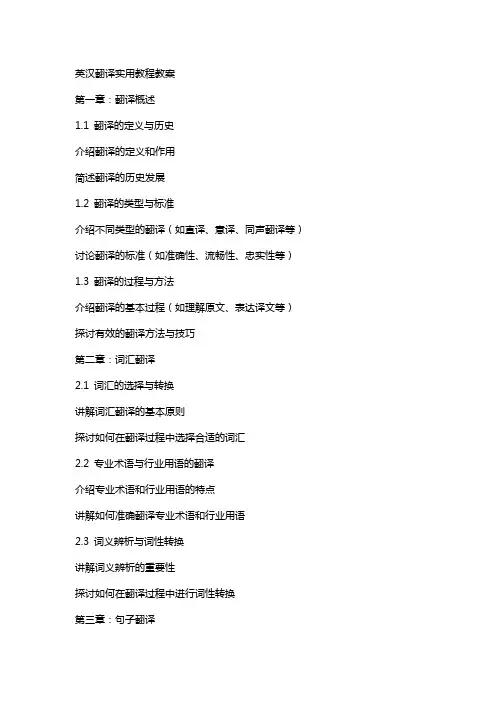
英汉翻译实用教程教案第一章:翻译概述1.1 翻译的定义与历史介绍翻译的定义和作用简述翻译的历史发展1.2 翻译的类型与标准介绍不同类型的翻译(如直译、意译、同声翻译等)讨论翻译的标准(如准确性、流畅性、忠实性等)1.3 翻译的过程与方法介绍翻译的基本过程(如理解原文、表达译文等)探讨有效的翻译方法与技巧第二章:词汇翻译2.1 词汇的选择与转换讲解词汇翻译的基本原则探讨如何在翻译过程中选择合适的词汇2.2 专业术语与行业用语的翻译介绍专业术语和行业用语的特点讲解如何准确翻译专业术语和行业用语2.3 词义辨析与词性转换讲解词义辨析的重要性探讨如何在翻译过程中进行词性转换第三章:句子翻译3.1 句型结构与句子成分讲解英语和汉语句型结构的差异探讨如何在翻译过程中保持句子成分的平衡3.2 语法调整与句子重构讲解语法调整的重要性探讨如何在翻译过程中进行句子重构3.3 意译与直译的运用讲解意译和直译的区别与适用场景探讨如何在翻译过程中灵活运用意译和直译第四章:段落与文章翻译4.1 段落结构与主题句的翻译讲解段落结构的重要性探讨如何翻译段落主题句4.2 逻辑与连贯性的保持讲解翻译过程中逻辑和连贯性的重要性探讨如何保持原文的逻辑和连贯性4.3 文章风格与翻译策略讲解不同文章风格的特征探讨如何根据文章风格选择合适的翻译策略第五章:文化差异与翻译5.1 文化背景与翻译讲解文化背景对翻译的影响探讨如何在翻译过程中考虑文化背景5.2 文化词汇与翻译讲解文化词汇的特点和翻译难点探讨如何准确翻译文化词汇5.3 跨文化交流与翻译实践讲解跨文化交流的重要性探讨如何在翻译实践中应对跨文化交流的挑战第六章:翻译技巧与策略6.1 翻译中的直译与意译深入探讨直译与意译的定义和应用场景分析直译与意译在实际翻译案例中的运用6.2 翻译中的归化与异化讲解归化与异化的概念和作用探讨如何在翻译过程中运用归化和异化策略6.3 翻译中的补偿与调整分析翻译中补偿与调整的必要性和方法通过实例展示补偿与调整在翻译中的应用第七章:文学翻译7.1 文学翻译的基本原则探讨文学翻译的特殊性和原则分析文学翻译中应注重的方面7.2 诗歌、小说、戏剧等文体的翻译深入讲解不同文学文体的翻译特点和技巧通过实例分析不同文学文体的翻译方法7.3 文学翻译案例分析分析具体文学作品的翻译案例讨论文学翻译中的难点和解决策略第八章:商务翻译8.1 商务翻译的基本要求讲解商务翻译的特点和基本要求分析商务翻译中应注重的方面8.2 商务合同、广告、报告等文体的翻译深入讲解不同商务文体的翻译特点和技巧通过实例分析不同商务文体的翻译方法8.3 商务翻译案例分析分析具体商务材料的翻译案例讨论商务翻译中的难点和解决策略第九章:口译技巧与实践9.1 口译的基本类型与技巧讲解同声传译、交替传译等口译类型的特点探讨口译过程中的技巧和策略9.2 口译中的听力理解与信息处理分析听力理解在口译中的重要性讲解如何提高口译中的信息处理能力9.3 口译实践案例分析提供口译实践案例,进行分析和讨论指导如何应对口译中的挑战和困难第十章:翻译软件与工具的使用10.1 翻译软件的种类与功能介绍市面上的主要翻译软件及其功能分析翻译软件的优缺点和使用场景10.2 翻译辅助工具的使用讲解翻译辅助工具(如在线词典、术语管理工具等)的运用探讨如何提高翻译效率和质量10.3 翻译软件与人工翻译的结合讨论翻译软件与人工翻译的结合方式分析如何利用翻译软件辅助人工翻译工作重点和难点解析6.1 直译与意译的界定和应用场景是教学中的重点和难点。
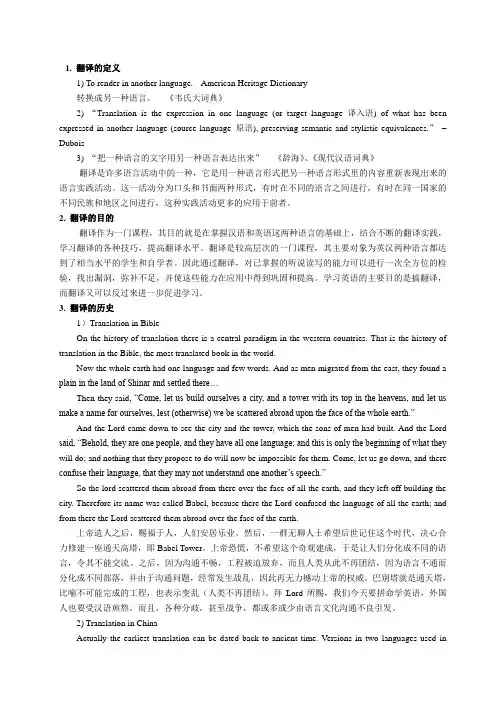
1. 翻译的定义1) To render in another language. --American Heritage Dictionary转换成另一种语言。
--《韦氏大词典》2) “Translation is the expression in one language (or target language 译入语) of what has been expressed in another language (source language 原语), preserving semantic and stylistic equivalences.”–Dubois3) “把一种语言的文字用另一种语言表达出来”--《辞海》、《现代汉语词典》翻译是许多语言活动中的一种,它是用一种语言形式把另一种语言形式里的内容重新表现出来的语言实践活动。
这一活动分为口头和书面两种形式,有时在不同的语言之间进行,有时在同一国家的不同民族和地区之间进行,这种实践活动更多的应用于前者。
2. 翻译的目的翻译作为一门课程,其目的就是在掌握汉语和英语这两种语言的基础上,结合不断的翻译实践,学习翻译的各种技巧,提高翻译水平。
翻译是较高层次的一门课程,其主要对象为英汉两种语言都达到了相当水平的学生和自学者。
因此通过翻译,对已掌握的听说读写的能力可以进行一次全方位的检验,找出漏洞,弥补不足,并使这些能力在应用中得到巩固和提高。
学习英语的主要目的是搞翻译,而翻译又可以反过来进一步促进学习。
3. 翻译的历史1)Translation in BibleOn the history of translation there is a central paradigm in the western countries. That is the history of translation in the Bible, the most translated book in the world.Now the whole earth had one language and few words. And as men migrated from the east, they found a plain in the land of Shinar and settled there…Then they said, “Come, let us build ourselves a city, and a tower with its top in the heavens, and let us make a name for ourselves, lest (otherwise) we be scattered abroad upon the face of the whole earth.”And the Lord came down to see the city and the tower, which the sons of men had built. And the Lord said, “Behold, they are one people, and they have all one language; and this is only the beginning of what they will do; and nothing that they propose to do will now be impossible for them. Come, let us go down, and there confuse their language, that they may not understand one another’s speech.”So the lord scattered them abroad from there over the face of all the earth, and they left off building the city. Therefore its name was called Babel, because there the Lord confused the language of all the earth; and from there the Lord scattered them abroad over the face of the earth.上帝造人之后,赐福于人,人们安居乐业。
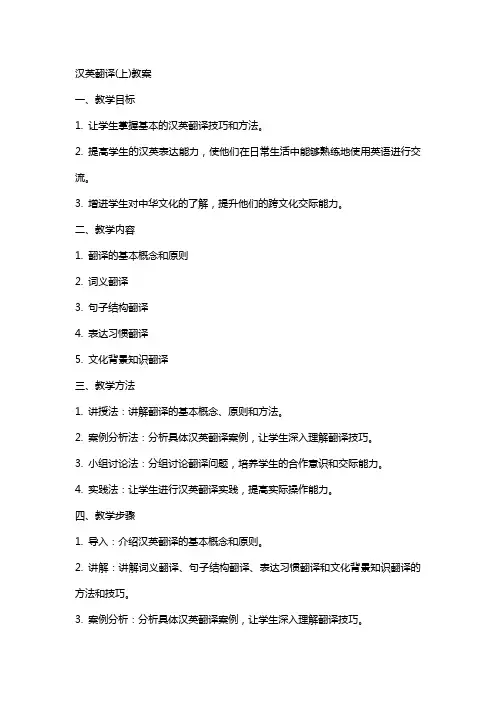
汉英翻译(上)教案一、教学目标1. 让学生掌握基本的汉英翻译技巧和方法。
2. 提高学生的汉英表达能力,使他们在日常生活中能够熟练地使用英语进行交流。
3. 增进学生对中华文化的了解,提升他们的跨文化交际能力。
二、教学内容1. 翻译的基本概念和原则2. 词义翻译3. 句子结构翻译4. 表达习惯翻译5. 文化背景知识翻译三、教学方法1. 讲授法:讲解翻译的基本概念、原则和方法。
2. 案例分析法:分析具体汉英翻译案例,让学生深入理解翻译技巧。
3. 小组讨论法:分组讨论翻译问题,培养学生的合作意识和交际能力。
4. 实践法:让学生进行汉英翻译实践,提高实际操作能力。
四、教学步骤1. 导入:介绍汉英翻译的基本概念和原则。
2. 讲解:讲解词义翻译、句子结构翻译、表达习惯翻译和文化背景知识翻译的方法和技巧。
3. 案例分析:分析具体汉英翻译案例,让学生深入理解翻译技巧。
4. 小组讨论:分组讨论翻译问题,培养学生的合作意识和交际能力。
5. 实践:让学生进行汉英翻译实践,提高实际操作能力。
五、教学评估1. 课堂参与度:观察学生在课堂上的发言和讨论情况,评估他们的学习积极性。
2. 翻译实践:评估学生的汉英翻译作品,检查他们的翻译水平和应用能力。
3. 课后作业:布置相关汉英翻译作业,检查学生的学习效果。
4. 小组讨论:评估学生在小组讨论中的表现,检查他们的合作意识和交际能力。
六、教学资源1. 教材:选用权威的汉英翻译教材,如《汉英翻译教程》、《现代汉英翻译》等。
2. 案例资料:收集各类汉英翻译案例,包括文学、影视、新闻、广告等不同领域的翻译实例。
3. 网络资源:利用互联网资源,如翻译论坛、专业博客、在线课程等,为学生提供丰富的学习资料。
4. 辅助工具:提供翻译软件和在线词典等辅助工具,帮助学生提高翻译效率。
七、教学环境2. 网络环境:确保教室网络畅通,方便学生查阅在线资源和进行汉英翻译实践。
3. 设备设施:准备投影仪、计算机、音响等教学设备,以便进行多媒体教学。
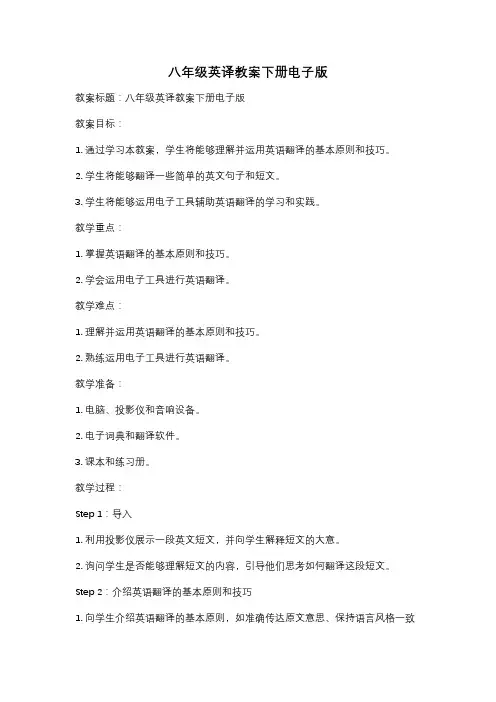
八年级英译教案下册电子版教案标题:八年级英译教案下册电子版教案目标:1. 通过学习本教案,学生将能够理解并运用英语翻译的基本原则和技巧。
2. 学生将能够翻译一些简单的英文句子和短文。
3. 学生将能够运用电子工具辅助英语翻译的学习和实践。
教学重点:1. 掌握英语翻译的基本原则和技巧。
2. 学会运用电子工具进行英语翻译。
教学难点:1. 理解并运用英语翻译的基本原则和技巧。
2. 熟练运用电子工具进行英语翻译。
教学准备:1. 电脑、投影仪和音响设备。
2. 电子词典和翻译软件。
3. 课本和练习册。
教学过程:Step 1:导入1. 利用投影仪展示一段英文短文,并向学生解释短文的大意。
2. 询问学生是否能够理解短文的内容,引导他们思考如何翻译这段短文。
Step 2:介绍英语翻译的基本原则和技巧1. 向学生介绍英语翻译的基本原则,如准确传达原文意思、保持语言风格一致等。
2. 向学生介绍英语翻译的技巧,如理解上下文、注意词义的多义性等。
Step 3:示范翻译1. 选择一些简单的英文句子,向学生示范如何进行翻译。
2. 解释翻译过程中的一些关键点和注意事项。
Step 4:学生练习1. 将学生分成小组,让他们互相练习翻译一些简单的英文句子。
2. 鼓励学生在翻译过程中互相讨论和交流,提供帮助和建议。
Step 5:引入电子工具1. 向学生介绍一些常用的电子工具,如电子词典和翻译软件。
2. 演示如何使用这些电子工具进行英语翻译,包括查找单词释义、翻译句子等。
Step 6:学生实践1. 让学生使用电子工具进行英语翻译的实践,例如翻译一篇简短的英文文章。
2. 监督学生的实践过程,提供必要的指导和帮助。
Step 7:总结和评价1. 总结本节课所学的英语翻译原则和技巧。
2. 对学生的表现进行评价,鼓励他们在以后的学习中继续努力。
教学延伸:1. 鼓励学生在课后继续使用电子工具进行英语翻译的练习。
2. 提供一些相关的阅读材料,让学生进行更多的翻译实践。
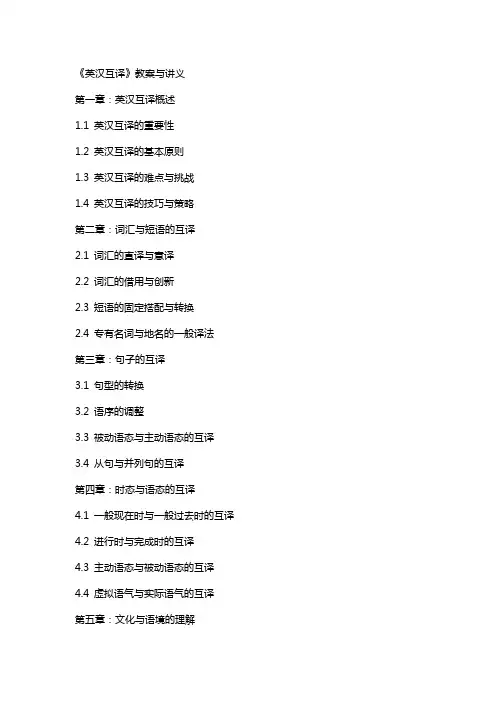
《英汉互译》教案与讲义第一章:英汉互译概述1.1 英汉互译的重要性1.2 英汉互译的基本原则1.3 英汉互译的难点与挑战1.4 英汉互译的技巧与策略第二章:词汇与短语的互译2.1 词汇的直译与意译2.2 词汇的借用与创新2.3 短语的固定搭配与转换2.4 专有名词与地名的一般译法第三章:句子的互译3.1 句型的转换3.2 语序的调整3.3 被动语态与主动语态的互译3.4 从句与并列句的互译第四章:时态与语态的互译4.1 一般现在时与一般过去时的互译4.2 进行时与完成时的互译4.3 主动语态与被动语态的互译4.4 虚拟语气与实际语气的互译第五章:文化与语境的理解5.1 文化背景知识的重要性5.2 语境的理解与运用5.3 语言习惯与表达方式的差异5.4 跨文化交流的技巧与策略第六章:翻译标准与原则6.1 翻译标准的历史演变6.2 忠实原则与达意原则6.3 等效翻译与功能翻译6.4 翻译中的创译与意译第七章:翻译技巧与策略(上)7.1 词义选择与词性转换7.2 修辞格的翻译7.3 成语与谚语的翻译7.4 诗歌与文学作品的语言特点与翻译第八章:翻译技巧与策略(下)8.1 幽默与讽刺的翻译8.2 商务与法律文本的翻译8.3 科技与医学文本的翻译8.4 翻译中的校对与润色第九章:实践案例分析9.1 英汉互译案例分析9.2 翻译错误分析与避免9.3 翻译实践与反馈9.4 翻译作品的评价与赏析第十章:翻译软件与辅助工具10.1 翻译软件的种类与功能10.2 翻译辅助工具的使用10.3 语料库与在线翻译资源10.4 在翻译领域的应用与展望重点和难点解析一、英汉互译概述难点解析:理解英汉两种语言的结构差异,如语序、句型、时态和语态的使用,以及文化背景和语境的理解。
二、词汇与短语的互译难点解析:不同语言中词汇的内涵和外延可能存在差异,需要根据语境进行适当的调整。
三、句子的互译难点解析:不同语言的句子结构差异,如主被动语态的转换,以及保持原意的调整语序。
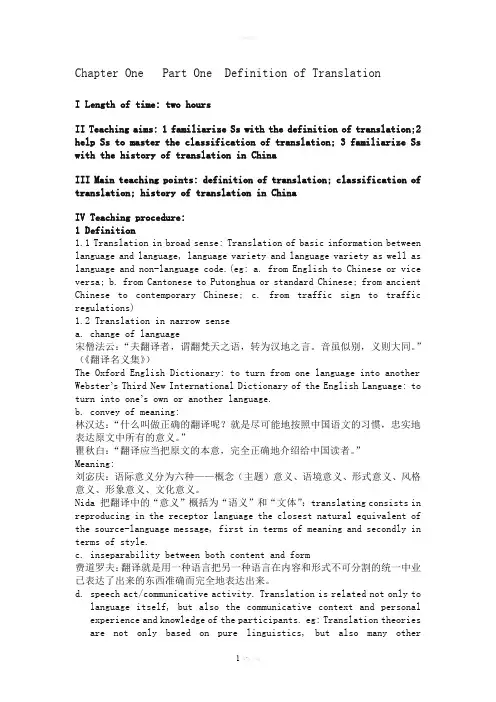
Chapter One Part One Definition of TranslationI Length of time: two hoursII Teaching aims: 1 familiarize Ss with the definition of translation;2 help Ss to master the classification of translation; 3 familiarize Ss with the history of translation in ChinaIII Main teaching points: definition of translation; classification of translation; history of translation in ChinaIV Teaching procedure:1 Definition1.1 Translation in broad sense: Translation of basic information between language and language, language variety and language variety as well as language and non-language code.(eg: a. from English to Chinese or vice versa; b. from Cantonese to Putonghua or standard Chinese; from ancient Chinese to contemporary Chinese; c. from traffic sign to traffic regulations)1.2 Translation in narrow sensea.change of language宋僧法云:“夫翻译者,谓翻梵天之语,转为汉地之言。
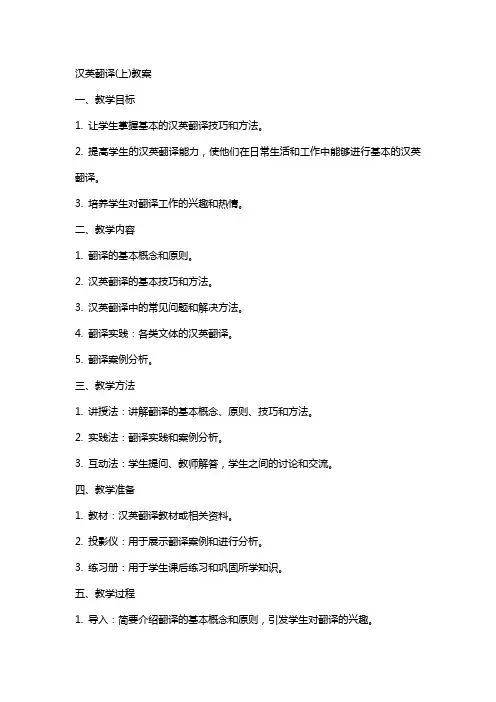
汉英翻译(上)教案一、教学目标1. 让学生掌握基本的汉英翻译技巧和方法。
2. 提高学生的汉英翻译能力,使他们在日常生活和工作中能够进行基本的汉英翻译。
3. 培养学生对翻译工作的兴趣和热情。
二、教学内容1. 翻译的基本概念和原则。
2. 汉英翻译的基本技巧和方法。
3. 汉英翻译中的常见问题和解决方法。
4. 翻译实践:各类文体的汉英翻译。
5. 翻译案例分析。
三、教学方法1. 讲授法:讲解翻译的基本概念、原则、技巧和方法。
2. 实践法:翻译实践和案例分析。
3. 互动法:学生提问、教师解答,学生之间的讨论和交流。
四、教学准备1. 教材:汉英翻译教材或相关资料。
2. 投影仪:用于展示翻译案例和进行分析。
3. 练习册:用于学生课后练习和巩固所学知识。
五、教学过程1. 导入:简要介绍翻译的基本概念和原则,引发学生对翻译的兴趣。
2. 新课内容:讲解汉英翻译的基本技巧和方法,结合实际案例进行分析。
3. 翻译实践:让学生进行各类文体的汉英翻译练习,教师进行指导和点评。
4. 案例分析:分析典型的汉英翻译案例,讲解其中的翻译策略和技巧。
5. 课堂讨论:学生提问、教师解答,学生之间进行讨论和交流。
6. 课后作业:布置翻译练习,让学生课后巩固所学知识。
六、教学评估1. 平时成绩:观察学生在课堂上的参与程度、提问和回答问题的表现,以及课后作业的完成情况,给予相应的平时成绩。
2. 期中考试:设置期中考试,测试学生的汉英翻译能力,包括理论知识和实践应用。
3. 期末考试:进行期末考试,全面考核学生的汉英翻译水平,包括翻译理论和实践操作。
七、教学反思1. 教师应定期进行教学反思,总结教学过程中的优点和不足,不断改进教学方法和策略。
2. 关注学生的学习反馈,及时调整教学内容和方法,以满足学生的学习需求。
3. 积极参加教研活动,与其他教师交流教学经验,提升自身教学水平。
八、教学拓展1. 组织学生参加汉英翻译比赛或活动,提高他们的翻译能力和竞争意识。
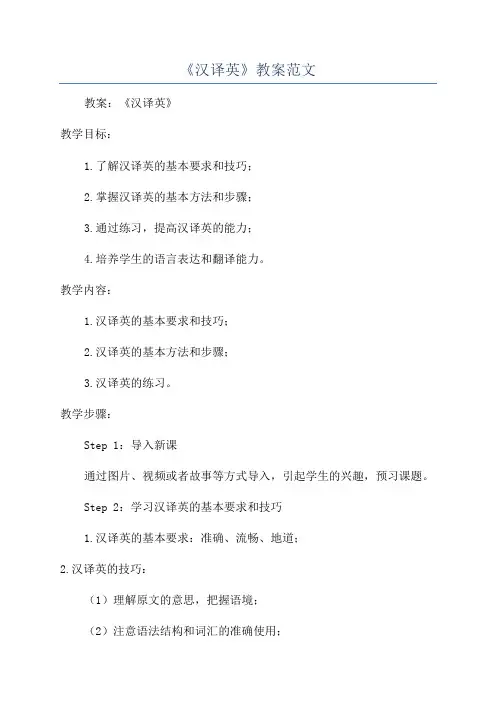
《汉译英》教案范文教案:《汉译英》教学目标:1.了解汉译英的基本要求和技巧;2.掌握汉译英的基本方法和步骤;3.通过练习,提高汉译英的能力;4.培养学生的语言表达和翻译能力。
教学内容:1.汉译英的基本要求和技巧;2.汉译英的基本方法和步骤;3.汉译英的练习。
教学步骤:Step 1:导入新课通过图片、视频或者故事等方式导入,引起学生的兴趣,预习课题。
Step 2:学习汉译英的基本要求和技巧1.汉译英的基本要求:准确、流畅、地道;2.汉译英的技巧:(1)理解原文的意思,把握语境;(2)注意语法结构和词汇的准确使用;(3)运用恰当的表达方式和惯用语;(4)注意使用科技产品和网络资源。
Step 3:学习汉译英的基本方法和步骤1.汉译英的基本方法:逐词逐句翻译、归纳概括翻译、情景翻译、意译等;2.汉译英的基本步骤:(1)理解原文的意思,分析句子结构;(2)查找相关资料,积累相关词汇和用法;(3)逐句逐词进行翻译;(4)进行润色和修改,使翻译更加准确、地道。
Step 4:汉译英练习教师出示一些常见的句子或短文,要求学生进行汉译英练习,可以分小组进行,提高学生的实际操作能力。
Step 5:总结和评价教师总结本节课的内容和要点,并对学生的表现进行评价和鼓励。
Step 6:布置作业布置相关的汉译英练习作业,鼓励学生在家里进行更多的练习。
教学辅助工具:图片、视频、板书等。
教学方法:讲授法、讨论法、实践法。
教学评估:观察学生在课堂上的表现和参与情况,布置课后作业进行评估。
教学资源:教材、网络资源、课外阅读材料等。
教学建议:1.鼓励学生多读、多听,并扩大词汇量;2.提供丰富的语言材料,培养学生的综合运用能力;3.通过小组讨论和角色扮演等方式,激发学生的积极参与和合作精神;4.及时反馈学生的学习情况,及时帮助学生解决问题。
教学延伸:1.加大汉译英的练习量,提高学生的翻译能力;2.组织学生进行口译和笔译的练习,培养学生的听说读写能力;3.组织学生进行翻译比赛,激发学生的学习兴趣和竞争意识。
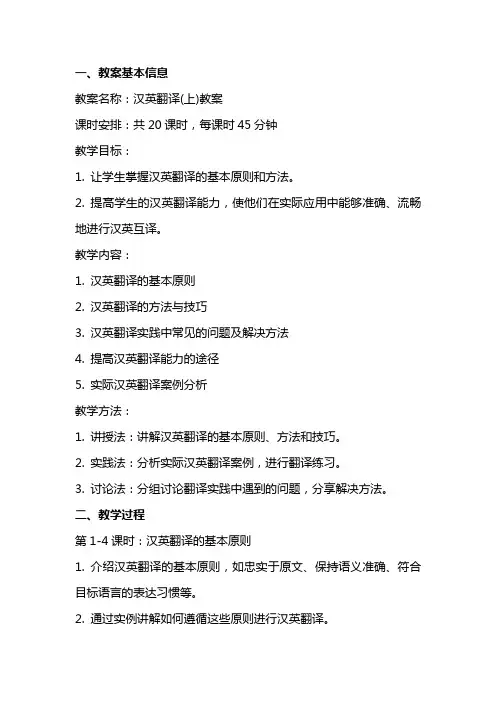
一、教案基本信息教案名称:汉英翻译(上)教案课时安排:共20课时,每课时45分钟教学目标:1. 让学生掌握汉英翻译的基本原则和方法。
2. 提高学生的汉英翻译能力,使他们在实际应用中能够准确、流畅地进行汉英互译。
教学内容:1. 汉英翻译的基本原则2. 汉英翻译的方法与技巧3. 汉英翻译实践中常见的问题及解决方法4. 提高汉英翻译能力的途径5. 实际汉英翻译案例分析教学方法:1. 讲授法:讲解汉英翻译的基本原则、方法和技巧。
2. 实践法:分析实际汉英翻译案例,进行翻译练习。
3. 讨论法:分组讨论翻译实践中遇到的问题,分享解决方法。
二、教学过程第1-4课时:汉英翻译的基本原则1. 介绍汉英翻译的基本原则,如忠实于原文、保持语义准确、符合目标语言的表达习惯等。
2. 通过实例讲解如何遵循这些原则进行汉英翻译。
3. 进行翻译练习,让学生运用所学原则进行实际翻译。
第5-8课时:汉英翻译的方法与技巧1. 介绍汉英翻译的方法,如直译、意译、借译等。
2. 讲解汉英翻译的技巧,如词类转换、词义扩展与缩小、句型变换等。
3. 通过实例让学生练习运用这些方法和技巧进行翻译。
第9-12课时:汉英翻译实践中常见的问题及解决方法1. 分析汉英翻译实践中常见的问题,如词语搭配、语法结构、文化背景等。
2. 讲解解决这些问题的方法,如查阅词典、了解目标语言的文化背景、寻求专业人士的意见等。
3. 让学生通过实际翻译案例,练习解决这些问题。
第13-16课时:提高汉英翻译能力的途径1. 介绍提高汉英翻译能力的途径,如多阅读、多练习、参加翻译培训等。
3. 进行翻译练习,检验学生的翻译能力。
三、教学评价1. 课堂参与度:观察学生在课堂上的积极参与程度,提问和回答问题的积极性。
2. 翻译练习:评估学生的翻译练习成果,检查翻译的准确性、流畅性和符合目标语言的表达习惯。
3. 小组讨论:评价学生在小组讨论中的表现,如合作态度、分享精神等。
四、教学资源1. 教材:汉英翻译相关教材、案例分析资料。
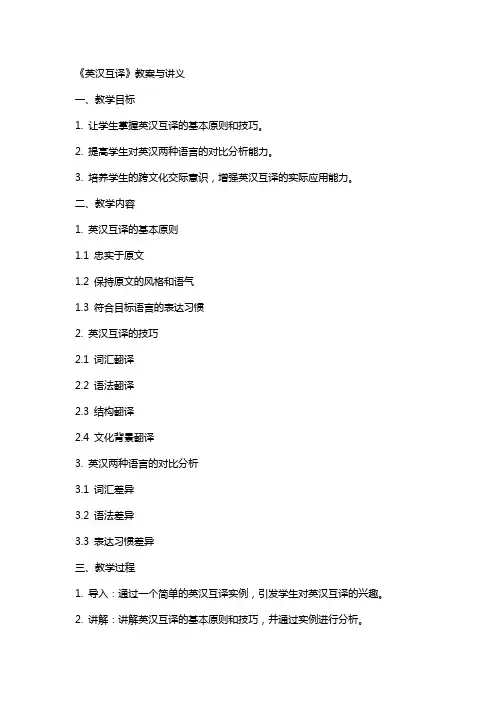
《英汉互译》教案与讲义一、教学目标1. 让学生掌握英汉互译的基本原则和技巧。
2. 提高学生对英汉两种语言的对比分析能力。
3. 培养学生的跨文化交际意识,增强英汉互译的实际应用能力。
二、教学内容1. 英汉互译的基本原则1.1 忠实于原文1.2 保持原文的风格和语气1.3 符合目标语言的表达习惯2. 英汉互译的技巧2.1 词汇翻译2.2 语法翻译2.3 结构翻译2.4 文化背景翻译3. 英汉两种语言的对比分析3.1 词汇差异3.2 语法差异3.3 表达习惯差异三、教学过程1. 导入:通过一个简单的英汉互译实例,引发学生对英汉互译的兴趣。
2. 讲解:讲解英汉互译的基本原则和技巧,并通过实例进行分析。
3. 对比分析:分析英汉两种语言的差异,并讲解如何在翻译过程中进行调整。
4. 练习:布置适量的英汉互译练习题,让学生进行实践操作。
四、教学方法1. 讲授法:讲解英汉互译的基本原则、技巧和语言差异。
2. 案例分析法:通过实例分析,让学生理解和掌握英汉互译的方法。
3. 练习法:让学生通过实际操作,提高英汉互译的能力。
五、教学评价1. 课堂参与度:观察学生在课堂上的积极参与情况和提问回答。
2. 练习完成情况:检查学生完成的英汉互译练习质量和数量。
3. 课后反馈:收集学生的课后反馈,了解他们对英汉互译的认识和困惑。
六、教学资源1. 教材:《英汉互译教程》2. 辅助材料:英汉互译案例集、多媒体课件3. 网络资源:相关英汉互译的在线资料和论坛七、教学环境1. 教室:宽敞、安静,有利于学生集中注意力2. 设备:投影仪、计算机、音响等教学设备八、教学进度安排1. 第一课时:介绍英汉互译的基本原则和技巧2. 第二课时:分析英汉两种语言的差异3. 第三课时:讲解英汉互译的实践操作4. 第四课时:布置练习题,进行课堂练习九、课后作业1. 复习本节课的内容,整理笔记2. 完成布置的英汉互译练习题3. 收集英汉互译相关的资料,进行自主学习十、教学反思2. 对学生的反馈进行整理,针对存在的问题进行调整教学策略3. 不断更新教学资源,提高自身教学水平,以更好地为学生服务重点和难点解析一、教学目标难点解析:跨文化交际意识的培养和实际应用能力的提升。
英汉翻译实用教程教案第一章:翻译概念与原则1.1 翻译的定义解释翻译的概念和本质强调翻译的目标:传递信息、保持原文意义和风格1.2 翻译原则准确原则:确保翻译内容的准确性忠实原则:保持原文的精神和风格通俗易懂原则:确保译文适合目标读者对等原则:尽量找到等效的表达方式1.3 翻译标准解释中国的翻译标准:信、达、雅探讨翻译标准的实际应用和灵活性第二章:翻译技巧与策略2.1 直译与意译解释直译和意译的概念及适用场合强调直译和意译的平衡使用2.2 词义转换与词性变化介绍词义转换的技巧:根据上下文确定词义讲解词性变化的方法:名词转译为动词、形容词转译为副词等2.3 长句翻译分析长句的结构和特点讲解长句翻译的策略:断句、合句、调整语序等第三章:英汉语言对比与翻译3.1 英汉语言特点对比分析英语和汉语的语音、语法、词汇等方面的差异强调了解和掌握这些差异对翻译的重要性3.2 文化差异与翻译介绍英汉文化差异对翻译的影响讲解翻译中文化适应和文化保留的方法3.3 翻译中的常见问题和解决方法分析英汉翻译中常见的困难和问题提供解决这些问题的方法和技巧第四章:不同文体翻译技巧4.1 文学翻译技巧讲解诗歌、小说、戏剧等文学作品的翻译方法强调文学翻译中的艺术性和创造性4.2 商务翻译技巧介绍商务合同、广告、报告等文体的翻译要点强调商务翻译的准确性和专业性4.3 科技翻译技巧讲解科技文章、专利文件等文体的翻译方法强调科技翻译的准确性和专业性第五章:翻译工具与资源5.1 翻译软件与工具介绍常用的翻译软件和在线翻译工具强调翻译软件的辅助作用,不能完全依赖5.2 参考资料与资源介绍翻译中常用的参考资料:词典、手册、专业书籍等强调广泛阅读和积累知识的重要性5.3 翻译团队与协作强调团队合作在翻译项目中的重要性介绍有效的翻译协作方法和工具第六章:口译技巧与实践6.1 口译类型与特点解释同声传译、交替传译等口译类型的区别强调口译中的即时性和准确性6.2 口译技巧讲解听力理解、短期记忆、语言表达等口译技巧强调练习和提高口译能力的重要性6.3 口译实践提供口译练习场景和实例鼓励学生进行模拟练习,提高口译实战能力第七章:本地化与国际化翻译7.1 本地化概念与流程解释本地化的概念和目的讲解本地化的流程:市场调研、翻译、适应性修改等7.2 国际化翻译介绍国际化翻译的原则和方法强调在翻译中考虑不同文化和市场的适应性7.3 翻译案例分析提供实际的翻译案例分析案例中的本地化和国际化翻译策略第八章:翻译评估与反馈8.1 翻译质量评估标准介绍翻译质量评估的主要标准:准确性、流畅性、忠实度等强调评估过程中的客观性和公正性8.2 翻译错误分析分析常见的翻译错误类型:语义错误、语法错误、文化错误等提供避免和纠正这些错误的方法8.3 翻译反馈与改进强调反馈在翻译过程中的重要性讲解如何有效地接收和利用反馈,提高翻译水平第九章:翻译职业规划与发展9.1 翻译职业概述介绍翻译行业的现状和发展趋势强调翻译职业的挑战和机遇9.2 翻译职业规划指导学生进行翻译职业规划提供提升翻译能力和职业发展的建议9.3 翻译伦理与职业素养介绍翻译职业的伦理规范和职业素养强调翻译工作中的责任感和专业精神第十章:翻译案例研究与分析10.1 经典翻译案例研究分析经典的翻译案例:文学作品、历史文献、名人演讲等讲解案例中的翻译策略和技巧10.2 现代翻译案例分析分析现代社会中的翻译案例:广告、电影、网络内容等强调翻译在现代社会中的重要作用和影响力10.3 学生翻译作品点评提供学生的翻译作品点评作品中的优点和不足,提出改进建议重点解析本文教案主要围绕英汉翻译实用教程展开,涵盖了翻译概念、原则、技巧、策略、英汉语言对比、翻译工具与资源、口译技巧与实践、本地化与国际化翻译、翻译评估与反馈、翻译职业规划与发展以及翻译案例研究与分析等十个章节。
Chapter 1 Introduction1.1 Comparison between English & Chinese Cultures1.1.1 Definition of Culture“…Culture or Civilization, taken in its wide ethnographic sense, is that complex whole which includes knowledge, belief, art, morals, law, custom, and any other capabilities and habits acquired by man as a member of society..” This insight, so profound in its simplicity, opened up an entirely new way of perceiving and understanding human life. Implicit within Tylor’s definition is the concept that culture is learned, shared, and patterned behavior.1.1.2 Culture & Language语言既是一种社会现象,也是一种文化现象。
语言与文化是同时产生,相互依存,并行发展的,它们是紧密地交织在一起的。
语言是文化的产物,又是文化的媒介,它的形成与发展离不开民族的社会历史和文化。
所以我们认为,是文化的一面镜子——没有语言,就没有文化;从另一个方面看,语言又受文化的影响,反映一个民族的特征,它不仅包含着该民族的历史和文化背景,而且蕴藏着该民族对人生的看法、生活方式和思维方式。
不了解一门语言中的社会文化,就无法真正掌握和运用该语言。
从这个意义上讲,习得一种语言就意味着习得与那种语言相关联的文化。
英汉翻译教案范文教案:英汉翻译教学目标:1.学生能够准确理解英汉翻译的基本原理和方法。
2.学生能够使用正确的翻译技巧将英文翻译成中文。
3.学生能够运用所学知识,独立完成一篇简单的英汉翻译。
教学重点:1.英汉翻译的基本原理和方法。
2.翻译技巧的运用。
教学难点:1.如何有效运用翻译技巧。
2.如何把握好英汉翻译的语言风格。
教学过程:一、导入(10分钟)1.教师与学生互动,询问学生对英汉翻译的理解。
2.呈现一段英文短文,让学生尝试翻译成中文。
3.学生尝试用翻译软件进行翻译,比较不同翻译结果的准确性和流畅度。
二、基本原理介绍(20分钟)1.教师介绍英汉翻译的基本原理,如准确传递信息、保持语言风格等。
2.教师详细解释基本原理,比如意译和直译的区别、上下文的重要性等。
3.学生通过教师提供的例子,理解原理的应用。
三、翻译技巧讲解(30分钟)1.教师介绍几种翻译技巧,如同义替换、增添补充信息等。
2.教师详细解释各种翻译技巧的使用方法和注意事项。
3.学生通过练习题,运用所学翻译技巧进行翻译。
四、实际操作(30分钟)1.学生分组,每组选择一段英文短文进行翻译。
2.学生在小组内协作,运用所学翻译技巧完成翻译任务。
3.学生将翻译结果展示给全班,并互相评价。
五、总结与反思(10分钟)1.教师总结本节课所学的内容,强化学生对英汉翻译的理解。
2.学生反思自己在翻译过程中遇到的问题和不足。
3.教师给予学生反馈和建议,鼓励学生继续努力提高翻译水平。
教学资源:1.英文短文2.翻译软件3.练习题教学评估:1.学生在小组协作中的表现。
2.学生翻译的准确性和流畅度。
3.学生对翻译技巧的理解和运用。
教学延伸:1.学生可以进一步学习翻译的高级技巧和技巧,如词汇选择、语法转换等。
2.学生可以自主扩展翻译技能,进行更复杂的翻译任务。
教学反思:1.教学目标和重点难点的设置是否合理。
2.教学过程是否能够激发学生的学习兴趣和主动性。
3.教学资源的充分利用和教学评估的准确性。
《英汉互译》教案与讲义教案章节一:英汉互译概述教学目标:1. 了解英汉互译的基本概念和原则。
2. 掌握英汉互译的基本技巧和方法。
3. 能够进行简单的英汉互译实践。
教学内容:1. 英汉互译的概念和定义。
2. 英汉互译的原则和标准。
3. 英汉互译的基本技巧和方法。
4. 英汉互译的实践案例分析。
教学活动:1. 引入英汉互译的概念和定义。
2. 讲解英汉互译的原则和标准。
3. 介绍英汉互译的基本技巧和方法。
4. 提供实践案例,让学生进行翻译练习。
教学评价:1. 学生能够回答英汉互译的概念和定义。
2. 学生能够理解英汉互译的原则和标准。
3. 学生能够掌握英汉互译的基本技巧和方法。
4. 学生能够进行简单的英汉互译实践。
教案章节二:词汇与翻译1. 了解词汇在英汉互译中的重要性。
2. 掌握英汉词汇的差异和转换方法。
3. 能够准确翻译词汇和短语。
教学内容:1. 词汇在英汉互译中的作用和重要性。
2. 英汉词汇的差异和转换方法。
3. 常见词汇和短语的翻译实例。
教学活动:1. 引入词汇在英汉互译中的作用和重要性。
2. 讲解英汉词汇的差异和转换方法。
3. 提供常见词汇和短语的翻译实例。
4. 让学生进行词汇翻译练习。
教学评价:1. 学生能够理解词汇在英汉互译中的重要性。
2. 学生能够掌握英汉词汇的差异和转换方法。
3. 学生能够准确翻译常见词汇和短语。
教案章节三:语法与翻译教学目标:1. 了解语法在英汉互译中的重要性。
2. 掌握英汉语法的差异和转换方法。
3. 能够正确翻译句子和段落。
1. 语法在英汉互译中的作用和重要性。
2. 英汉语法的差异和转换方法。
3. 常见语法错误的分析和纠正。
教学活动:1. 引入语法在英汉互译中的作用和重要性。
2. 讲解英汉语法的差异和转换方法。
3. 提供常见语法错误的分析和纠正。
4. 让学生进行句子和段落的翻译练习。
教学评价:1. 学生能够理解语法在英汉互译中的重要性。
2. 学生能够掌握英汉语法的差异和转换方法。
大学英汉翻译
大学英汉翻译教案
一、教学目标:
1.了解英汉翻译的基本原则和步骤
2.了解英汉翻译的常见错误和解决方法
3.训练学生英汉翻译的实际操作能力
二、教学内容:
1.英汉翻译的基本原则和步骤
2.英汉翻译的常见错误和解决方法
3.英汉翻译实例练习
三、教学方法:
1.理论讲解法
2.实例分析法
3.讨论引导法
四、教学步骤:
Step1. 导入
老师通过PPT以及相关视频、图片等多媒体资料普及英汉翻译知识,并要求学生对基
本原则和步骤做初步理解。
Step2. 分析案例
老师选取学生们熟悉的实例,结合PPT和多媒体以英汉对照的形式呈现,让学生们自
己思考一下如何翻译,然后展开讨论。
Step3. 解决问题
在学生们准备好自己的翻译版本之后,老师根据学生们的答案,分析其中存在的问题,并且指出学生翻译中出现的各种错误。
Step4. 练习与巩固
老师在教学结束前要求学生自主翻译一些常见的英文句子或文章,并对他们的翻译进
行综合评价。
五、教学评估:
学生在课堂上积极参与课堂讨论,能够熟练掌握英汉翻译的基本原则和步骤,并能够
熟练运用英汉翻译相关技巧进行实践操作。
六、教学建议:
1.鼓励学生多多互动,可以让他们带着自己翻译的版本来参加讨论,发现更多的问题。
2.可以采用多种形式的教学资料,比如可以让学生去网上找翻译资料,或者从英文原
版图书的角度去分析。
3.在课堂上,老师要对文章的结构和语言进行深入的解析,以帮助学生更好的理解翻
译内容,同时也需要加强对常见错误的纠正和解决,帮助学生更好的提高英汉翻译水平。